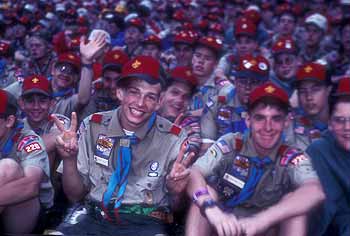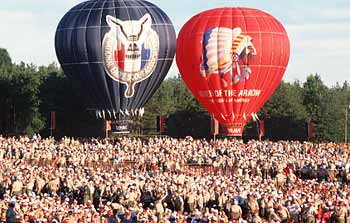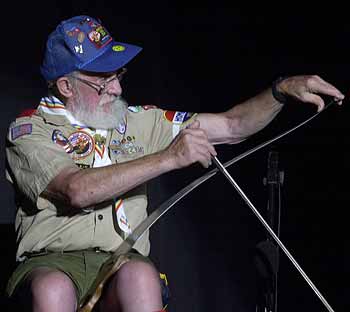A Spirit of Time and Place
By Jon C. Halter
Scouts and leaders who attend next summer's national jamboree at Fort A.P. Hill in Virginia will bring home a special set of memories and a lifelong attachment to "the jamboree spirit."
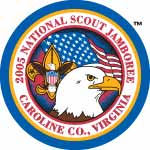
Every four years, an immense tent city housing thousands of Scouts, leaders, and staff appears for several days on the grounds of the U.S. Army's Fort A.P. Hill in Virginia—then vanishes.
Next summer, from July 25 to Aug. 3, that quadrennial encampment will reappear in the form of the 16th National Scout Jamboree, with the theme "On My Honor—Timeless Values."
The 2005 jamboree will be the seventh consecutive one at what is now the jamboree's permanent site, located near Fredericksburg, Va., between Richmond and Washington, D.C.
By late August, however, other than permanent plumbing and other service facilities, little evidence will be left to show that more than 40,000 Scouts, leaders, and staff had recently camped on the site for 10 days.
Although physically gone, every jamboree remains alive in the memories of those who attend. The special "jamboree spirit"—symbolized by the candles all Scouts light at every jamboree closing ceremony—lives on in the hearts and minds of everyone fortunate to have been part of the experience.
Memories are made of this
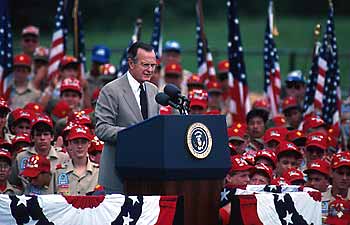 Highlight of the 1989 jamboree at Fort A. P. Hill was the personal visit and address by President George H. Bush. Photographs Courtesy of BSA Archives |
After next summer, more than 660,000 Scouts and leaders will have attended the BSA's 16 national jamborees since 1937; of those, more than 245,000, or 37 percent, will have attended a jamboree held at Fort A.P. Hill.
Scouts who attended national jamborees—at sites ranging from Washington, D.C. (1937), Colorado Springs, Colo. (1960), Irvine Ranch, Calif. (1953), and Valley Forge, Pa. (1950, 1957, 1964)—tend to believe each unique setting made "their" jamboree unmatched by any other location or year.
That feeling holds true at Fort A.P. Hill. Even though the location has remained the same since 1981, almost every Scout who attends a jamboree in Caroline County, Va., recalls the occasion as a Scouting event like no other, filled with vivid memories and unforgettable one-of-a-kind experiences.
1981: 'Scouting's Reunion With History'
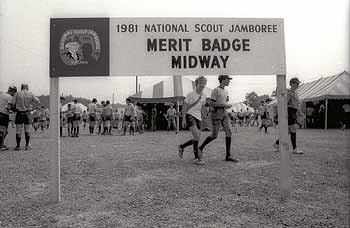 The 1981 jamboree establsihed the spectacular Merit Badge Midway as a Fort A.P. Hill tradition. |
With a facility named after famed Confederate Gen. A. P. Hill, and surrounded with countless nearby historical attractions, including Washington, D.C., Mount Vernon, Jamestown, Williamsburg, and Civil War and Revolutionary War battlefields, to name only a few, it was no surprise that the first A.P. Hill jamboree focused on history and patriotism.
The opening arena show featured 2,400 Scouts performing skits and songs dedicated to "America's Heritage." The evening's celebrity performers symbolized the transition from old to new, as the Oak Ridge Boys shared the spotlight with veteran folk singer Burl Ives, a performer at previous jamborees.
Earlier jamborees had a Merit Badge Midway, but 1981 saw it established as a major Fort A.P. Hill attraction. Scouts could learn from a host of experts as they worked on any of 64 badges.
The reenactment of the first Scout camp—Baden-Powell's 1907 experimental testing of his Scouting program on Brownsea Island, off the coast of England—also had been introduced at previous jamborees. At Fort A.P. Hill, however, it was given a permanent site. Boys and leaders, wearing typical clothes from 1907, showed visitors the activities the original Brownsea campers had enjoyed in the process of proving that B-P's "system" worked.
1985: 'The Spirit Lives On'
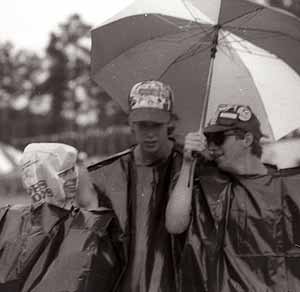 Hurricane Bob couldn't dampen camper enthusiasm in 1985. |
As 1985 marked the Diamond Jubilee of the Boy Scouts of America, the theme of the 11th National Scout Jamboree celebrated the enduring nature of the spirit of Scouting.
And that spirit was put to the test early by an unexpected visitor named Bob—Hurricane Bob. Although reduced to a tropical depression by the time the storm roared into Fort A.P. Hill, Bob still flattened tents, knocked down gateways, soaked sleeping bags, and turned pathways to mud.
But Scouting perseverance paid off. By midweek the sun was out, the ground was drying, and Bob was soon forgotten. Scouts focused on the fun activities in the Challenge Trail, fishing and boating, and visiting the 92 booths at the largest Merit Badge Midway to date.
New jamboree activities included board-sailing on lower Travis Lake, snorkeling in aboveground pools, a trap shooting range, and a bicycle motocross (BMX) course.
Onstage, the Beach Boys were the celebrity entertainers, but the No. 1 guest of honor was First Lady Nancy Reagan, substituting for her husband, President Ronald Reagan, who was ill.
1989: 'The Adventure Begins...With America's Youth'
Scouting magazine's November-December 1989 cover recorded the highlight moment of the 12th National Scout Jamboree, as Chief Scout Executive Ben H. Love welcomed President George H. W. Bush to the arena speaker's podium.
The president, who had just stepped out of Marine One, the official presidential helicopter that landed next to the arena, obviously enjoyed the occasion and praised the Scouts for their tradition of conducting Good Turns and waging a campaign against the use of harmful drugs by youth.
The official jamboree patch featured an image of a space shuttle, and the 20 subcamps were each named after a NASA space mission. The huge NASA exhibit, featuring mock-ups of rockets and space vehicles, captured the attention of jamboree campers and visitors.
The popular IBM booth at the Merit Badge Midway reported 4,000 visitors, while 290 Scouts completed the Computers merit badge. And hundreds of Scouts daily visited the Boys' Life exhibit to try and decipher a new attraction, the Codemaster Challenge.
Jamboree historians noted at least two "firsts":
Propane gas stoves replaced charcoal grills, which had been used for patrol cooking since 1950.
